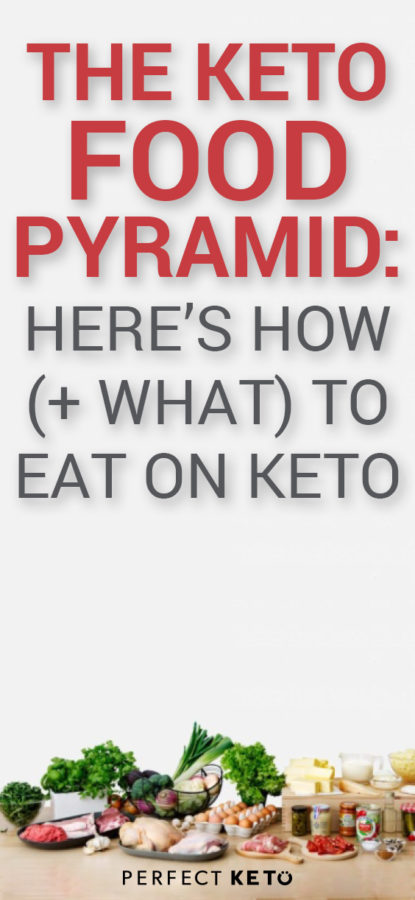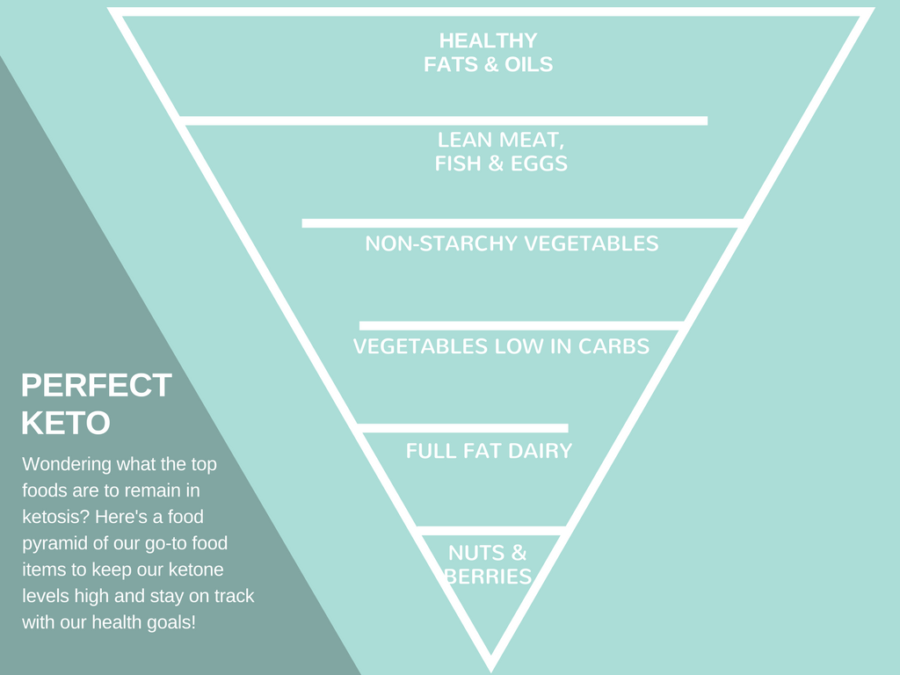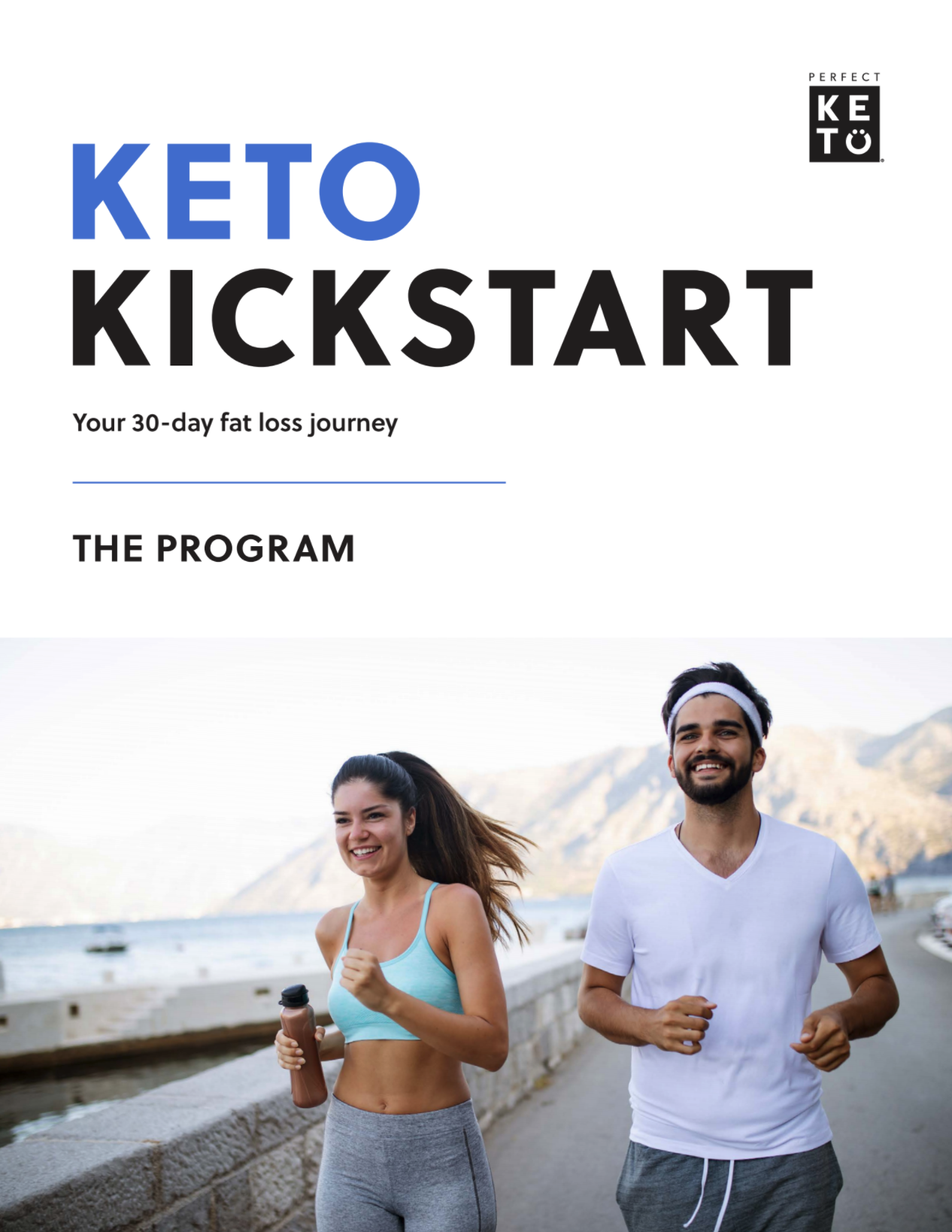Remember when you were younger and learned about the food pyramid?
This triangular-shaped diagram of food groups helped you visualize exactly how many servings of each macro you were supposed to eat every day
The bad news is the traditional food pyramid is built on a bed of quick-digesting, unhealthy carbs.
So is there a keto food pyramid you can use to learn the same ideas?
If you’ve been struggling with what to eat to reach ketosis, you’re not alone.
Completely reversing the way you’ve been eating your entire life is often the most challenging part about starting a keto diet.
But this doesn’t have to be the case — and after today, it won’t be.
In this guide, I’ll show you a handy cheat sheet we like to call the Perfect Keto Food Pyramid to help you plan your diet in a healthy, keto-friendly way.
Since most of us are visual learners, you can study this image to get a better idea of how to strike the right balance of food groups to reach and maintain ketosis.
Here’s what else I have in store for you today:
To start, let’s go over the basics of the pyramid.

How to Use the Perfect Keto Food Pyramid
While a food pyramid seems straightforward enough, our Keto Food Pyramid is a bit different.
Each of the six tiers are filled with foods you should be eating on a ketogenic diet.
If you take a look at the pyramid below, you’ll notice it’s inverted or upside-down compared to the traditional one. This top heavy layer is done purposefully.

The food groups at the top are those which should make up the majority of your diet.
As for the ones all the way at the bottom, these foods should still be included in your diet, but in much smaller quantities.
Let’s go over each level of the keto food pyramid now.
First and Foremost: How to Reach Your Fat Intake
The majority of your calories (70–80%) should come from healthy fats (the top two tiers of the pyramid).
The best fat sources on keto include:
- Grass-fed butter
- Ghee
- Coconut oil
- MCT oil (powder options work well too)
- Flaxseed oil
- Avocado oil
- Sesame oil
- Fish and krill oil
- Fatty cuts of grass-fed beef and red meat
- Fatty fish like tuna, salmon and mackerel
- Pumpkin seeds
- Chia seeds
- Flaxseeds
You’ll notice full fat dairy and nuts, which are usually associated with being high fat, aren’t included in this list. Since these may contain extra carbs, they’re closer to the bottom of the PK Food Pyramid as you’ll see later.
Do you know what 30g of fat looks like? Check out this guide to find out!
Another point to consider when it comes to choosing your fat is where it’s sourced from.
Your meat should be grass-fed, your fish wild-caught from sustainable fisheries and your oils should be stored and used properly so they can maintain their structural integrity (i.e., so you can reap all the benefits).
Knowing where your food is coming from ensures you’re not also loading up on unnecessary chemicals, antibiotics or hormones that come with commercial low-quality meat sources.
Even if you eat a healthy keto diet, yet you’re still consuming hormone-filled meats, you’re doing your health a disservice.
This is the one area where you don’t want to be cheap.
If you have to cut corners, save on your Starbucks and start making your own Bulletproof coffee and you’ll have enough spare change to upgrade to high-quality fat sources.
Not only is that better for your wallet, it will help you hit your macro and health goals with ease.
Now let’s take a look at protein as it relates to the pyramid.
Meeting Your Protein Requirements
You may have noticed a good portion of the fat sources I just mentioned are also rich in protein too.
This means you can cross off multiple macronutrients in just those foods alone.
But when it comes to protein on keto, there’s a huge misconception that this way of eating is high in both fat and protein.
That’s not the case at all.
A standard keto diet, with the exception of a high-protein version, means only a moderate amount of protein is consumed.
On a ketogenic diet, only 20–25% of your calories come from protein, which is less than or equal to a quarter of your total daily calories.
So if you’re new to keto and you’ve been doing a 50/50 split with protein and fat, it’s no wonder you haven’t reached ketosis yet.
This is another one of the most common mistakes people make in the early stages of keto.
And that’s why I’m placing so much emphasis here; it’s essential you get this balance right or ketosis won’t be in your reach.
Use your results from the macronutrient calculator (more on this later!) to see just how much protein you need; then make sure you’re hitting your targets each day, without going over them.
Ideal sources of protein falling under the second tier category of Lean Meat, Fish and Eggs on the keto pyramid include:
Keep in mind, that doesn’t mean you should shy away from fatty cuts of meat either. Quite the opposite. However, these shouldn’t become your everyday go-to’s.
A healthy balance will include a mix of fatty and lean cuts of meat.
Some fattier cuts still rich in nutrients include:
- Organ meat (hearts, liver, tongue and kidney)
- Steak
- Veal
- Lamb
- Cured meats like salami and pepperoni
To give you an idea, an average keto meal may only involve 3–5 oz. of protein.
This portion will depend on your individual needs and what you determine when you count your macros.
To learn more about how much protein is necessary on a keto diet, check out this guide.
Up next, you’ll find out how to manage those pesky carbs on keto.
The Tipping Point: How to Stay Under Your Carb Allowance
On keto, your smallest macronutrient is always carbs, which is why it’s much lower on the Keto Food Pyramid.
But that doesn’t mean you should pay any less attention to them.
In fact, if you don’t pay enough attention to where you’re at carb-wise during the course of the day, you won’t reach ketosis.
For most people to enter and stay in ketosis, a range of 20-50 grams of net carbs per day is a good goal to aim for.
One of the most noticeable differences between the Keto Food Pyramid carbs and the MyPlate version on the Standard American Diet (SAD) is that carbs aren’t listed as grains, breads and pastas.
To keep carb counts as low as possible, you should be getting small amounts of carbs from veggies like broccoli, cauliflower and asparagus.
Many vegetables under the Non-Starchy Vegetables tier of the pyramid have very low net carb numbers, meaning you can get plenty of volume without ruining your daily macro budget.
For a better idea of what 30 grams of carbohydrates looks like, check out this guide.
The last two tiers of the pyramid are for dairy and nuts and berries, which I’ll dive into next.
What About Dairy on Keto?
If you’re someone who likes cheese, the good news is that you can enjoy it on keto, as long as you choose the right kinds and you practice portion control.
You’ll notice dairy towards the bottom of the pyramid and that’s also done for good reason: dairy is not something you want to load up on.
In the case of milk, there’s close to 13g of carbs in just one glass alone[*].
But consuming dairy can help you reach your fat and protein goals for the day so it’s not necessarily bad when eaten in moderation.
With that said, if you are going to enjoy dairy on a keto diet, reach for these sources:
- Grass-fed butter
- Ghee
- Heavy whipping cream
- Fermented yogurts, Greek yogurt, and kefir
- Sour cream (full fat)
- Hard cheeses (parmesan, gouda, blue cheese)
- Soft cheeses (whole mozzarella, brie, monterey jack)
And for readers who don’t like dairy, you can opt out of this category altogether without jeopardizing your chances of reaching ketosis.
To learn more about dairy on keto, make your way over to this guide when you’re finished here.
This brings us to the very tip of the pyramid.
Go Easy On Nuts And Fruit
Certain nuts and fruit can be beneficial on keto, but in both cases, they must be accounted for in your daily macro budget.
And, as with everything, you’ll need to choose your sources wisely.
This is why you’ll find nuts and berries all the way at the bottom of the pyramid (read: you don’t need much).
Yes, most nuts are rich in fat and/or protein.
But many also deliver a side of carbs. So without the right portion control, you can easily go over budget within minutes.
The best nut to choose on keto is macadamia, hands down.
Not only are they 75% fat (a whopping 21.2 g of fat) per serving, they’re also an ideal low carb snack since they only set you back 2g of carbs.
More keto-friendly nuts include:
- Pecans
- Brazil nuts
- Walnuts
- Hazelnuts
- Pine nuts
- Almonds
- Pistachios
- Chestnuts
The nuts at the top of that list (pecans to hazelnuts) are lower in carbs than the ones towards the end (pine nuts to chestnuts).
Nut butters are also a convenient option for busy people, but heed caution! A serving is only two tablespoons so watch the sugar and carbs in that very small portion.
At just the right amount, nuts and nut butters deliver a healthy serving of fats, protein and micronutrients.
Fruit shares this same characteristic: a small amount of the right kind packs an antioxidant-rich boost for your health while too much natural sugar can ruin your chances of reaching ketosis.
Blackberries, raspberries, strawberries and blueberries are some of the best fruits to consume on keto.
Not only are they rich in powerful anti-inflammatory vitamins, they’re also lower in net carbs than tropical fruits like bananas and oranges — again, as long as you portion them out right.
Check out the net carbs in just 1 cup:
- 6g in blackberries
- 7g in raspberries
- 8g in strawberries
- 17g in blueberries
To learn more about the difference between total carbs and net carbs, check out this guide.
That wraps up each level of the Keto Food Pyramid.
But just remember this is an ideal balance; the kind you achieve when you make your own foods at home and have a better level of control over what you’re eating.
You should aim to eat this way everyday, but if you stick to the Keto Food Pyramid 90% of the time (and never go above your carb or protein macros), you should be better than okay.
Now, before you go run out with your handy cheat sheet of keto foods, there’s one more huge component to consider here: how much of each macro is right for you.
Stay with me. I’ll keep this super simple.
Determining Your Individual Needs
Consider the Keto Food Pyramid a tool to help you reach your keto and body goals.
It’s not a magic pill or a quick fix.
For it to work properly, you need to tailor your diet to your specific lifestyle and the goals you’re trying to achieve. That’s the only way it’s going to have the potential to work for you.
If you don’t give your body the right fuel, in the right quantities, you’re not going to feel your best.
And you can forget about reaching ketosis.
Let me explain.
If you decide to buy a sports car like a Lamborghini, but instead of filling it with premium gas like it requires only use the basic stuff, do you think it’s going to run right?
Even if it does, what happens if you don’t put enough gas in the tank? Will it take you very far?
This is how you should look at feeding your body. Your body is a powerful machine that needs the right fuel in the right quantities to go the distance and function well.
And if you want to feel better and reap all the benefits of a keto diet, this is not a rule you can tread lightly on.
So to help you out, here’s how to figure out how much of each macro you need:
Step 1: Understand the Macro Breakdown
Even if you hate math, you can still figure out your macro needs without it being a struggle.
The first step is simple.
On a keto diet, you want your macronutrients to be around:
- 70% to 80% fats
- 20% to 25% protein
- 5% to 10% net carbs
But the specifics of how many grams of each food group you need depends on several factors such as your age, gender, body goals and activity levels.
The next step is determining your calorie needs.
Step 2: Nail Down Your Calories
One of the most common mistakes people make when starting out on a keto diet with a weight loss goal in mind is not figuring out their daily calories (and sticking to them).
This step is crucial because it’s how you’ll determine how many calories you should be getting from fat, carbs and protein.
To determine your calorie needs, you need to calculate your Basal Metabolic Rate (BMR), which is just a fancy way of saying how many calories it takes just to run your body at rest.
From there, figure out how many calories you need to support your activity level, both during and outside of work, and not just in regards to exercise.
This is known as your Total Daily Energy Expenditure (TDEE).
Since these two formulas require more work than a straightforward multiplication, I’m going to send you to this comprehensive guide to calculate your numbers manually and this one that has a calculator to do the work for you.
But hold off on doing those calculations until you’ve finished reading this guide. I’ll give you the resources at the end so you don’t have to sift through the whole article again to find them.
Step 3: Use Your Calories to Find Your Macros
Once you do have your specific calorie count, you can then multiply the standard keto macro breakdown to find out how many calories and grams you need of each one.
Don’t forget to adjust these numbers if you don’t plan to follow a standard keto diet and are choosing to do a high protein or cyclical version instead, which are ideal for athletes specifically.
Essentially, all you really need to keep in mind is that you must eat meals that are 100% focused on hitting your nutrient goals.
This is where planning out your meals is key.
And why the healthiest and most nutrient dense sources of food from the Keto Food Pyramid may be able to help.
Putting It All Together: How to Live By the Keto Food Pyramid
Now that you have a better idea of how to use the Keto Food Pyramid, you’re ready to start creating healthy keto meals of your own.
First, determine your calorie needs and macronutrient breakdown.
Then, browse all the tasty recipes in the Perfect Keto kitchen to see which appeal to your palate and fit within your daily macro goals next (hint: we list macros for every recipe!).
To fill in the gaps and make grocery shopping temptation- and worry-free, check out this list of foods to eat on a ketogenic diet as well.
And if you’re not sure how to meal plan, consider using one of our jumpstart guides after you determine the calorie goal right for you:
- 7 Day Meal Plan Under 1,300 Calories
- 7 Day Meal Plan Under 1,600 Calories
- 7 Day Meal Plan Under 1,900 Calories
- 7 Day Meal Plan Under 2,200 Calories
With these tips and tools at your disposal, ketosis, weight loss and better health will finally be within your reach.
As promised, here’s a list of the most important resources mentioned in this guide:
- How to Calculate Your Macros
- Macro Calculator for Busy People Who Hate Math
- What 30g of Fat Looks Like
- How Much Protein is Safe on Keto?
- What 30g of Carbs Looks Like
- Complete Food List on Keto
- Keto and Dairy: What You Should Know
- What Are Net Carbs? And Should You Care?
